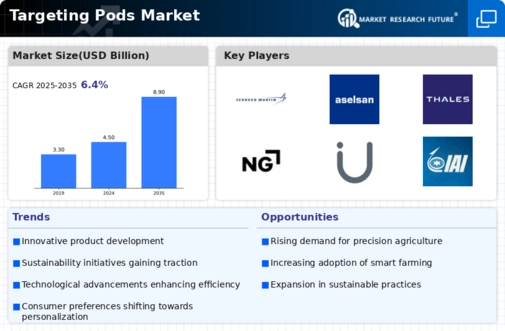Top Industry Leaders in the Targeting Pods Market

The list of key players acting as a driving force for the market is mentioned below:
Lockheed Martin (US)
Aselsan (Turkey)
Thales Group (France)
Raytheon Company (US)
Northrop Grumman (US)
L-3 Technologies (US)
Ultra Electronics (UK)
Israel Aerospace Industries (Israel)
MOOG Inc. (US)
FLIR Systems (US)
Rafael Advanced Defense Systems Ltd (Israel)
Qioptik (Paris)
Strategies Adopted
Industry news within the Targeting Pods Market often highlights successful targeting pod demonstrations, collaborations between defense contractors and military organizations, and advancements in sensor technologies for military applications. Companies regularly announce new contract awards, partnerships, and advancements in their targeting capabilities to showcase the reliability and efficiency of their solutions. Regulatory updates related to targeting pod standards, international collaborations in defense technology, and advancements in sensor integration also impact the competitive dynamics of the market, prompting companies to align their offerings with evolving requirements.
Current trends in company investments within the Targeting Pods Market reflect a notable focus on increasing sensor resolution, improving laser designator capabilities, and the integration of targeting pods into broader military platforms. Companies allocate resources to develop targeting solutions that enhance precision targeting capabilities, improve situational awareness, and ensure the effectiveness of military aircraft in various operational scenarios. Strategic partnerships, participation in defense technology forums, and collaboration with military agencies are common trends among key players to stay abreast of technological advancements and maintain competitiveness.
Emerging Companies
The overall competitive scenario in the Targeting Pods Market remains dynamic, with companies navigating evolving military requirements, technological advancements, and international defense policies. Established players face the challenge of continuously innovating to meet the changing needs of defense agencies and ensuring their targeting pod systems remain at the forefront of technology. The competition is expected to intensify as emerging companies secure contracts, introducing novel targeting technologies and challenging the market share of established targeting pod solution providers. In this environment, adaptability, responsiveness to defense requirements, and a commitment to technological excellence will be crucial for companies to maintain and enhance their competitive positions in the Targeting Pods Market.
Recent News
Secured a $570 million contract for the Sniper XR targeting pod for F-35 fighter jets, offering extended-range targeting capabilities and enhanced situational awareness for pilots.
Developing the LANTIRN Next Generation (NG) targeting pod, featuring advanced navigation, sensor fusion, and targeting technologies for future combat aircraft.
Partnering with Northrop Grumman to explore integrated sensor suites for fighter jets, potentially combining targeting pods with other sensors for comprehensive battlefield data gathering.
Won a $340 million contract to upgrade the AN/ASQ-236 Litening targeting pod for U.S. Air Force F-16 fighter jets, enhancing their precision targeting and laser designation capabilities.
Developed the Legion Pod, a next-generation targeting pod featuring active electronically scanned array (AESA) technology for wider signal detection and jamming capabilities.
Investing in research on artificial intelligence (AI) integration into targeting pods, aiming for automatic target recognition and faster, more efficient threat identification.
Delivered the L-3 Lynx targeting pod for F-18 fighter jets, featuring high-resolution imagery and laser designation capabilities for precision strike missions.
Developed the AN/AAS-36 Dragon's Eye targeting pod for unmanned aerial vehicles (UAVs), enabling long-range surveillance and targeting capabilities for smaller platforms.
Collaborating with the U.S. Air Force to explore sensor fusion technologies for targeting pods, combining data from multiple sensors for a more comprehensive picture of the battlefield.
Launched the Litening-G5 advanced targeting pod, featuring advanced sensors, image processing algorithms, and laser targeting capabilities for various platforms.
Developed the Spike EO/IR targeting pod for helicopters and unmanned aerial vehicles, offering lightweight and cost-effective targeting solutions for close-air support missions.
Partnering with other Israeli defense companies to develop networked targeting pod systems, enabling real-time data sharing between platforms for enhanced situational awareness and coordinated strike operations.










